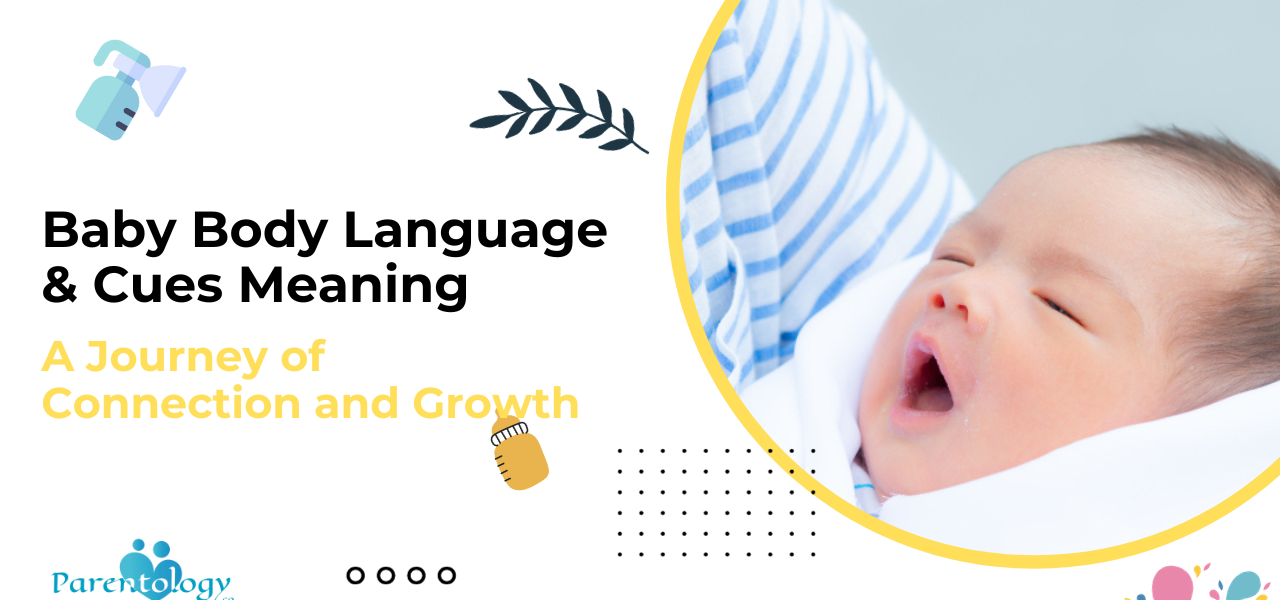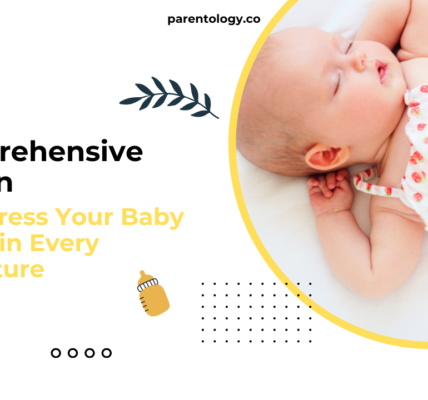Baby Body Language & Cues Meaning: A Journey of Connection and Growth
From the first gaze into your baby’s eyes, you’re entering a world of non-verbal communication. Babies express themselves through various cues, providing insights into their needs, emotions, and experiences. Understanding these cues is like unlocking a secret language, strengthening the parent-child bond. In this comprehensive guide, we’ll delve into 14 baby body language cues meaning, deciphering the cues meanings and helping you navigate the intricate landscape of early parenthood.
1. Eye Contact and Gaze:
- Early Connection: Babies engage in eye contact from the first weeks, establishing a foundation for emotional connection.
- Curiosity and Recognition: Prolonged gaze indicates curiosity, while recognizing familiar faces strengthens the bond with caregivers.
- Sign of Discomfort: Averting eyes may signal overstimulation or tiredness, providing cues for appropriate responses.
- Developmental Milestone: Improves with age, transforming from simple gaze to intentional eye contact with communicative intent.
2. Facial Expressions: Smiles and Pouts:
- Emotional Canvas: A baby’s face expresses joy, discomfort, or discontent through smiles, frowns, and pouts.
- Social Smiles vs. Genuine Expressions: Distinguishing between social and genuine smiles aids in understanding the baby’s emotional state.
- Emotional Bond: Responsive parenting to facial cues strengthens the emotional bond between the baby and caregivers.
- Mirror of Emotions: Observing facial expressions allows caregivers to respond effectively to the baby’s needs.


3. Hand Movements: Grasping and Waving:
- Communication through Gestures: Grasping gestures convey a need for closeness, while waving signals excitement or motor skill development.
- Early Motor Skills: Intentional hand movements emerge as part of the baby’s motor skill development.
- Cues for Interaction: Recognizing hand movements helps caregivers engage in interactive play, fostering cognitive development.
- Transition to Object Exploration: Gradual transition from reflexive hand movements to intentional grasping and exploring objects.
4. Body Posture: Arching and Curling:
- Discomfort Indicator: Arching may signify discomfort, gas, or overstimulation, prompting caregivers to address the issue.
- Security and Comfort: Curling up may indicate a need for comfort and security, providing cues for soothing techniques.
- Sleeping Postures: Understanding body postures during sleep aids in creating a comfortable sleep environment for the baby.
- Developmental Phase: Changes in body posture align with developmental milestones, offering insights into motor skill progression.
5. Sounds: Cooing and Crying:
- Expressive Sound Range: Babies communicate through coos, expressing contentment, and cries, signaling distress or discomfort.
- Interpreting Cries: Distinguishing hunger cries from tired cries enables caregivers to respond appropriately.
- Need for Comfort: Crying may indicate a need for comfort, feeding, or a diaper change, requiring attentive parental responses.
- Language Development: Early sounds contribute to language development, laying the foundation for future communication.
6. Rooting Reflex:
- Feeding Readiness: The rooting reflex, turning the head toward a touch on the cheek, signals a baby’s readiness to feed.
- Breastfeeding Cue: Recognizing the rooting reflex assists in establishing successful breastfeeding patterns.
- Duration of Reflex: Diminishing by around 4 months, the rooting reflex aligns with the baby’s evolving feeding techniques.
7. Leg Movements: Kicking and Stillness:
- Mood Indicator: Leg movements convey a baby’s mood, with kicking suggesting excitement and stillness indicating relaxation or fatigue.
- Developmental Sign: Intentional kicking emerges as babies discover their limbs and develop basic motor skills.
- Observation for Development: Noting leg movements aids in tracking motor skill milestones and overall physical development.
- Soothing Techniques: Responding to leg cues involves providing comfort or engaging in interactive play to soothe the baby.


8. Arching Back:
- Response to Discomfort: Arching of the back may signal discomfort, requiring caregivers to identify and address potential issues.
- Overstimulation Indicator: Recognizing back arching during stimulating activities allows for adjustments to create a calmer environment.
- Positional Comfort: Understanding back arching during certain positions helps in ensuring the baby’s comfort during play or rest.
9. Body Rigidity:
- Tension Indicator: Body rigidity suggests tension or discomfort, prompting caregivers to assess and address the potential causes.
- Growth and Flexibility: Changes in body rigidity align with the baby’s growth and flexibility development.
- Interactive Play: Recognizing body cues allows for modification of play activities to suit the baby’s comfort and developmental stage.
10. Fussiness and Clinginess:
- Comfort-Seeking Behavior: Fussiness and a desire to cling to caregivers often indicate a need for comfort, feeding, or closeness.
- Responsive Parenting: Prompt responses to clinginess contribute to the development of a secure attachment between the baby and caregivers.
- Infant Stress Indicator: Persistent fussiness may signal underlying discomfort or stress, necessitating thorough assessment.
11. Turning Away:
- Feeding Cues: Turning away during feeding may signify overstimulation or a temporary break needed by the baby.
- Cue for Parental Awareness: Observing turning away prompts caregivers to assess the feeding environment and adjust as needed.
- Feeding Rhythm: Understanding turning away as part of the feeding rhythm allows for a smoother and more comfortable feeding experience.
12. Leg Cycling Movements:
- Motor Skill Development: Leg cycling movements, especially during tummy time, indicate the progression of motor skills.
- Exploration Sign: Babies use leg cycling as a way to explore their body and the surrounding environment.
- Parental Engagement: Recognizing leg cycling cues facilitates engaging play activities that support further motor skill development.
13. Jerky Movements:
- Nervous System Development: Jerky movements, especially during sleep, are normal and align with the ongoing development of the baby’s nervous system.
- Transitional Reflexes: These movements reflect the transition from reflexive actions to intentional control over body movements.
- Observational Learning: Parents observing jerky movements gain insights into the intricacies of their baby’s neurological development.
14. Hiccuping:
- Common Occurrence: Hiccuping is a common, harmless occurrence in babies and is usually a result of the immaturity of their digestive system.
- Feeding Break Indicator: Frequent hiccuping during feeding may suggest a need for a short break or a slower feeding pace.
- Consultation Points: While usually benign, persistent or severe hiccuping might warrant a discussion with a pediatrician to rule out any underlying concerns.
Understanding these 14 cues meaning equips parents with the tools to navigate the rich landscape of their baby’s non-verbal communication, fostering a deeper connection and responsive parenting. Every cue, whether a coo, a kick, or a smile, serves as a unique expression of the baby’s evolving personality and developmental journey.


Observing and Responding to Baby’s Cues: A Parental Guide to Know Cues Meaning
Creating a Responsive Environment:
- Comfortable Sleep Space: Ensure a cozy and safe sleep space, as observing your baby’s sleep cues aids in establishing healthy sleep patterns.
- Interactive Play Areas: Design play areas that stimulate exploration and engage the baby’s senses, fostering cognitive and motor skill development.
- Feeding Readiness Awareness: Recognize cues meaning like rooting reflex and turning away during feeding, adjusting feeding schedules accordingly for a smoother experience.
Communication Through Touch:
- Gentle Touch: Respond to cues like arching or body rigidity with gentle touch, offering reassurance and promoting a sense of security.
- Tummy Time Techniques: Encourage leg cycling movements during tummy time, promoting core strength and facilitating motor skill milestones.
Navigating Fussy Phases:
- Cues for Calming Techniques: Identify fussiness cues early, employing calming techniques such as gentle rocking, swaying, or soothing music.
- Responsive Feeding: Address turning away cues during feeding by creating a calm feeding environment, adjusting positions for optimal comfort.
Embracing Individuality:
- Unique Developmental Timelines: Understand that each baby develops at their unique pace, and cues provide valuable insights into their individual developmental timelines.
- Catering to Preferences: As babies express preferences through cues, adapt parenting styles to learn all the cues meaning, cater to individual needs, fostering a harmonious parent-child relationship.
Seeking Professional Guidance:
- Persistent Cues: Consult a pediatrician if persistent cues indicate potential discomfort, stress, or developmental concerns.
- Open Communication: Establish open communication with healthcare providers, sharing observations of jerky movements or hiccuping for professional guidance.
Promoting Social Interaction:
- Encouraging Eye Contact: Foster emotional connection through frequent eye contact, supporting healthy social and emotional development.
- Interactive Play: Utilize cues like smiles and leg movements to engage in interactive play, enhancing the parent-child bond.
Recording Developmental Milestones:
- Maintain a Developmental Diary: Keep a diary tracking developmental milestones associated with cues, creating a valuable resource for both parents and healthcare providers.
- Capture Moments: Document moments of cooing, waving, or first intentional grasps, celebrating each developmental leap.
Connecting with Other Parents:
- Parental Support Networks: Join parent support networks or forums to share experiences, gain insights, and navigate the journey of decoding baby cues meaning collectively.
- Virtual Workshops: Participate in virtual workshops on understanding baby cues, staying informed about the latest research and parenting techniques.
Nurturing Emotional Intelligence:
- Modeling Emotional Expression: As babies observe facial expressions, model a range of emotional expressions, contributing to the development of emotional intelligence.
- Responsive Parenting: Know their babys’ cues meaning and promptly respond to cues with empathy, validating the baby’s emotions and reinforcing a secure attachment.


FAQs: Decoding Baby’s Cues Meaning
-
When do babies start making eye contact?
Ans. Babies typically start making eye contact within the first few weeks of life. However, the duration and purpose of eye contact evolve as they grow.
-
What is the difference between a social smile and a genuine smile in babies?
Ans. A social smile usually appears around 6-8 weeks and is a response to external stimuli. A genuine smile, fueled by emotions, emerges later, around 2-3 months.
-
Why do babies arch their backs?
Ans. Arching of the back in babies can indicate discomfort, gas, or overstimulation. Identifying the cause helps address the issue effectively.
-
How can parents differentiate between different types of cries?
Ans. Differentiating cries involves paying attention to the sound, intensity, and duration. Hunger cries may be rhythmic, while tired cries can be more whiny.
-
When do babies start kicking intentionally?
Ans. Intentional kicking usually starts around 2-3 months as babies begin to discover their limbs and develop basic motor skills.
-
What is the rooting reflex, and how long does it last?
Ans. The rooting reflex is a baby’s natural instinct to turn their head toward a touch on their cheek. It typically diminishes by 4 months.
-
Should parents respond immediately to every baby cue?
Ans. While prompt response is essential, parents also learn to gauge which cues meaning is which, which means they must give immediate attention and which allows for a bit of exploration and self-soothing.
-
Is hiccuping in babies a cause for concern?
Ans. Hiccuping is common in babies and is usually harmless. However, if it persists excessively, consulting a pediatrician is advisable.
-
How can parents encourage tummy time without causing discomfort?
Ans. Gradually introducing tummy time, using colorful toys or mirrors, and ensuring a soft surface can make the experience more enjoyable for the baby.
-
Can babies display different cues when they are overstimulated?
Ans. Yes, overstimulation in babies may lead to cues like avoiding eye contact, fussiness, and arching their back. Creating a calm environment can help soothe them.
Conclusion: Decoding the Language of Baby Cues Meaning
Understanding your baby’s body language is a profound way to connect and respond to their needs. By recognizing cues, parents can create a responsive environment, navigate fussy phases, and promote individualized development. Embracing the uniqueness of each baby, seeking professional guidance when needed, and nurturing emotional intelligence contribute to a harmonious parent-child relationship. Documenting developmental milestones and connecting with other parents through support networks enrich the parenting journey. By fostering interactive play, maintaining open communication with healthcare providers, and celebrating every coo and kick, parents embark on a fulfilling journey of decoding the rich language of baby cues.
Explore More: Parentology.co – Your guide to insightful parenting tips and resources.
Infographics:




